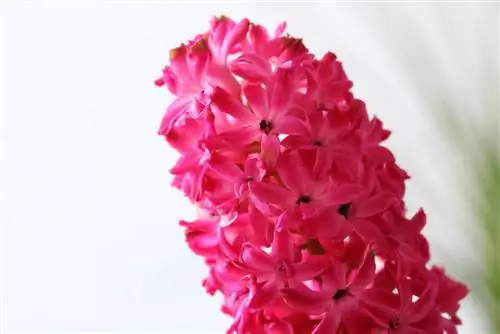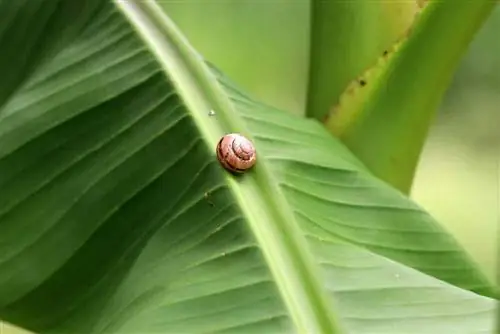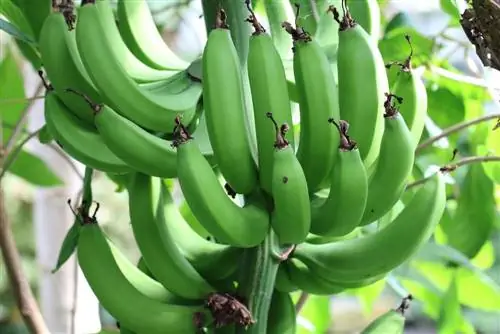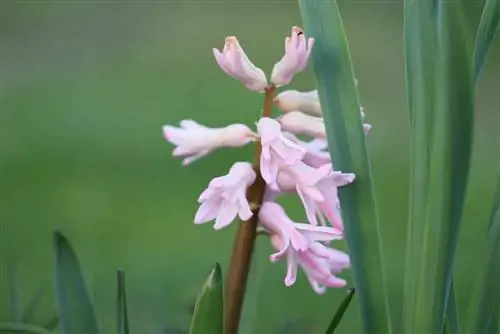- Author admin [email protected].
- Public 2023-12-17 03:39.
- Last modified 2025-01-24 12:45.
Hyacinths are not very picky about their location. They do feel most comfortable in the garden. But they also grow on balconies, terraces or in cool rooms. It can be used as an outdoor plant as well as a houseplant. The place you choose for the hyacinths can be partially shaded and cool or sunny and bright. Depending on how much space you have available and how you would like to present the noble plant. Even a heated room doesn't cause any major problems for her. You just have to accept the fact that it will wither more quickly when it is warm.
Optimal location for hyacinths
The best soil for plants is nutritious, humus-rich and permeable. If it is also sandy and has drainage, you are doing something particularly good for the plants. If you want to plant the plants in the garden, normal garden soil will also work. However, you should ensure that no waterlogging occurs, otherwise the plants could rot. Despite all this, the soil must always be kept slightly moist.
Watering and fertilizing hyacinths
- It is particularly important that hyacinths do not dry out. That's why they need to be watered regularly.
- This is the only way the roots can develop well and the plants can absorb sufficient nutrients.
- When watering, it is important to ensure that the plants are not standing in water.
- Before watering, the top layer of soil should be dry.
Hyacinths also don't make any great demands when it comes to fertilizing. Since the plants have to be repotted every year, you can save yourself the trouble of fertilizing them completely. If you don't want to repot, fertilize lightly in the fall. Compost or liquid fertilizer can be used for this. However, you should avoid animal fertilizers. Hyacinths don't like this and can even die from it.
Overwintering hyacinths
If you keep hyacinths as houseplants, overwintering them is quite easy. Once the flowering period is over, watering is gradually reduced. Once this is done, place the plants in a dark and cool place. Care is then no longer necessary. You should start doing this in October at the latest. If you repot the plants, cold treatment must take place after repotting. After repotting, you keep the plants moist for three weeks and then store them in a refrigerator for three weeks. The floral splendor develops again and you can enjoy it again. If you have the plants outdoors, overwintering is easier. The plants simply remain in the ground and overwinter in place.
Beware of pests
Hyacinths are difficult to protect from pests, especially outdoors. It is the vole that causes the most damage to plants in the wild. If this is the case, it is worth putting the onion in a basket or pot before placing it in the ground. This keeps the rodents away from the bulb and the plants can still be kept outdoors. In addition, sooty mold infestation can occur or skin and ringworm disease can break out. The only thing that helps here is replacing the soil and treating the bulb.
Caring for hyacinths
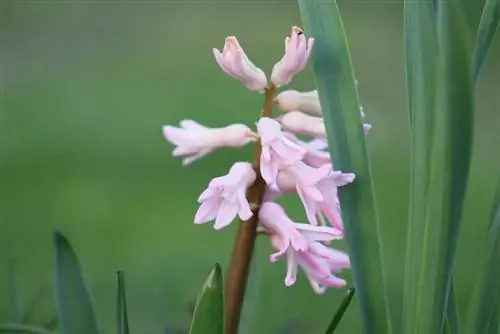
While the plants in the garden are quite easy to care for, as houseplants they need to be given more attention. In the garden it is sufficient if the location is sunny and the soil is moist. But it's not that easy in closed rooms. Care should be taken to ensure that the plants have gone through a cold phase before they bloom for the first time. Therefore, you should put them in the refrigerator for about two weeks before placing them in the apartment. Since hyacinths are poisonous plants, you should avoid contact with food.
If the hyacinths have bloomed, the faded elements are cut off. A sharp knife should be used for this. The leaves and stems are not cut off. If these were removed, it would weaken the bulb and the plants could die.
The toxicity of hyacinths
Hyacinths are poisonous. The plant substances contained in their combination are responsible for this. If you come into contact with these substances, it can cause skin damage. When working on and with plants, you should always wear gloves. And pets should also be kept away from the plants. If the animals were to eat these, the mucous membranes would become irritated and difficulty swallowing would occur. There is also nausea, which can lead to vomiting. If you observe this, you should definitely consult a veterinarian to prevent greater damage. In this context, one should also keep in mind that the symptoms of poisoning can appear with a time delay. The animal may not feel sick until hours later. Longer-term observation is therefore necessary.
They are also suitable as cut flowers, but at least the lowest flowers must be open. Their sweet scent attracts lots of bees and bumblebees, so they may not necessarily be planted right next to a seat!
Tip:
As with any flower bulb purchase, you should pay attention to the quality of the bulbs. Only firm and plump bulbs without injuries are strong enough to produce strong, beautiful flowers!
What you should know about hyacinths in brief
If you love the pleasant smell of flowers, you can't avoid the hyacinths, which originally come from the Mediterranean and belong to the lily family, with their intensely sweet-smelling flowers. They bloom in April-May and reach a height of 20-30 cm. A flower cluster full of squat, small flowers in white, pink, blue, yellow, red or purple then forms on the upright growing stems.
- Due to their generally low height, they are also very suitable as potted plants.
- Several hyacinths of one color planted together look best. The withered grapes are cut off including the stem.
- The leaves should only be removed when they wilt, as they will still absorb water and nutrients for the coming year.
- The best planting time is September. The bulbs are hardy and can safely remain in the same place for many years.
- They love the sun, but also feel comfortable in light shade. The soil should be permeable and sandy if possible.
- They resent waterlogging. In summer they prefer it to be a little drier rather than too wet.
- The planting depth is approx. 10 cm, the planting distance is also approx. 10 cm.
- Be careful with voles: They like the onions too! If danger threatens, put the bulbs in plant baskets.
Tip:
Since hyacinths are often somewhat naked at the base of the stem, it is a good idea to transplant them with other low spring bloomers with basal foliage such as pansies, primroses and daisies.
Growing hyacinths in a glass
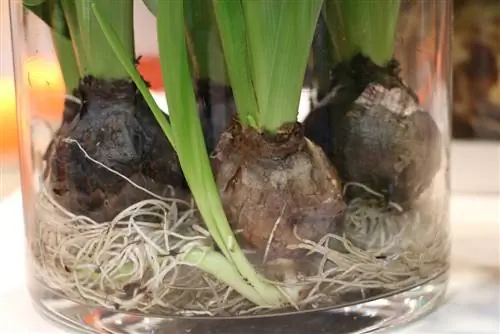
Prepared onions, i.e. onions that have been pre-treated for cold, are also available for purchase, which can then be grown in an onion jar. The glass should be wider at the bottom and then narrow enough to prevent an onion from falling through. Lukewarm water is now poured in at the bottom and the onion is then placed in the thickening. However, it must not touch the water, otherwise it will rot. There should be a finger gap distance and then roots will slowly form and grow towards the water. The water should be changed weekly. If you want to save yourself this, put a piece of activated carbon in the hyacinth jar. To sprout, it needs a cool, dark location such as a cellar or garage with temperatures around 10 °C. After about 12 weeks, the roots will fill the entire jar and the buds will appear. Then the glass can be placed back in a bright and warm place such as the windowsill and the flowering begins.
Special hyacinth varieties
- The double hyacinth 'Hollyhock' deserves special attention. Double hyacinths are very rare and the extraordinary bright red color of the flowers is also impressive. Filled varieties quickly become too heavy for the style and then bend easily. They should therefore be supported.
- Hyacinthoides hispanica - forest hyacinths - do not form real compact flower clusters, but rather have many individual small bells hanging from the style. They are available in white, pink and blue and are particularly recommended for natural gardens as they are ideal for growing wild. From year to year they bloom more abundantly and, above all, they like it even under trees and bushes.
- The unfortunately little-known giant hyacinth 'G altonia candicans' can even be planted in April and within a very short time it will become a lushly flowering plant with a magnificent white, even less compact, flower cluster that delights in summer. It grows to about one meter high.
- The little sisters of the hyacinth, the grape hyacinths Muscari aucheri, are only approx. 5-10 cm high and have small blue flower clusters. They don't work alone, so they should be planted in tuffs of around 20 bulbs. But they are also excellent companions to early-blooming tulips and daffodils.

